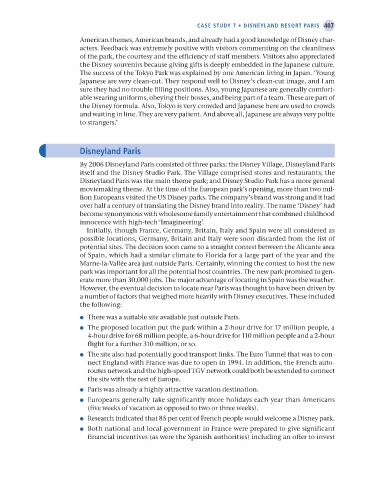Page 432 - Operations Strategy
P. 432
case study 7 • disneyland ResoRt PaRis 407
American themes, American brands, and already had a good knowledge of Disney char-
acters. Feedback was extremely positive with visitors commenting on the cleanliness
of the park, the courtesy and the efficiency of staff members. Visitors also appreciated
the Disney souvenirs because giving gifts is deeply embedded in the Japanese culture.
The success of the Tokyo Park was explained by one American living in Japan. ‘Young
Japanese are very clean-cut. They respond well to Disney’s clean-cut image, and I am
sure they had no trouble filling positions. Also, young Japanese are generally comfort-
able wearing uniforms, obeying their bosses, and being part of a team. These are part of
the Disney formula. Also, Tokyo is very crowded and Japanese here are used to crowds
and waiting in line. They are very patient. And above all, Japanese are always very polite
to strangers.’
Disneyland Paris
By 2006 Disneyland Paris consisted of three parks: the Disney Village, Disneyland Paris
itself and the Disney Studio Park. The Village comprised stores and restaurants; the
Disneyland Paris was the main theme park; and Disney Studio Park has a more general
moviemaking theme. At the time of the European park’s opening, more than two mil-
lion Europeans visited the US Disney parks. The company’s brand was strong and it had
over half a century of translating the Disney brand into reality. The name ‘Disney’ had
become synonymous with wholesome family entertainment that combined childhood
innocence with high-tech ‘Imagineering’.
Initially, though France, Germany, Britain, Italy and Spain were all considered as
possible locations, Germany, Britain and Italy were soon discarded from the list of
potential sites. The decision soon came to a straight contest between the Alicante area
of Spain, which had a similar climate to Florida for a large part of the year and the
Marne-la-Vallée area just outside Paris. Certainly, winning the contest to host the new
park was important for all the potential host countries. The new park promised to gen-
erate more than 30,000 jobs. The major advantage of locating in Spain was the weather.
However, the eventual decision to locate near Paris was thought to have been driven by
a number of factors that weighed more heavily with Disney executives. These included
the following:
● There was a suitable site available just outside Paris.
● The proposed location put the park within a 2-hour drive for 17 million people, a
4-hour drive for 68 million people, a 6-hour drive for 110 million people and a 2-hour
flight for a further 310 million, or so.
● The site also had potentially good transport links. The Euro Tunnel that was to con-
nect England with France was due to open in 1994. In addition, the French auto-
routes network and the high-speed TGV network could both be extended to connect
the site with the rest of Europe.
● Paris was already a highly attractive vacation destination.
● Europeans generally take significantly more holidays each year than Americans
(five weeks of vacation as opposed to two or three weeks).
● Research indicated that 85 per cent of French people would welcome a Disney park.
● Both national and local government in France were prepared to give significant
financial incentives (as were the Spanish authorities) including an offer to invest
Z07 Operations Strategy 62492.indd 407 02/03/2017 13:45

